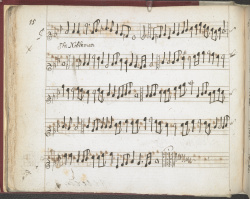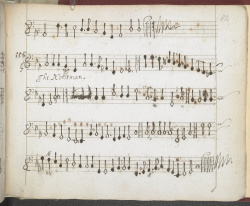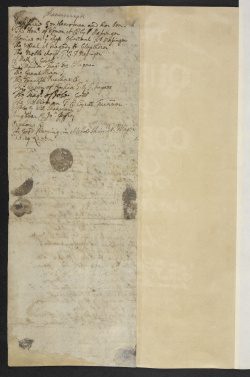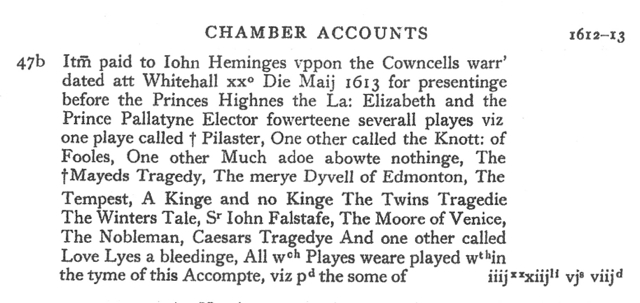Nobleman, The
Historical Records
Stationers' Register
15 February 1611 [i.e. 1612] (S.R.I, 3.478 (CLIO)
Edward Blunte Entred for his Copy vnder th'[h]andes of Sir GEORGE BUC[KE] and Th'wardens, A Play booke being a Tragecomedye called, The Noble man written by CYRILL TOURNEUR . . . . . . vjd
09 September 1653 (S.R.II, 1.429 CLIO)
- Master Mosely Entred also . . . the severall playes following . . xxs vjd
- ...
- The Nobleman or Great man, by Cyrill Tourneur.
Revels Accounts
1611-12.
- The, names, of the Playes And by what Cumpaney Played
them hearafter ffollowethe: As Allso what Maskes, and Triumphes
att the Tilte waere presented before the kinges Matie in this year. 1612
- The, names, of the Playes And by what Cumpaney Played
- The Kings Players: S\sh/roue; Sunday; A play Called the Noblman
- (The National Archive, AO 3/908/14, ff. 1v, 2r; qtd. MSC 13, 49.)
View a digitisation via the Folger Shakespeare Library's Shakespeare Documented exhibition.
To John Heminges for himselfe and his fellowes upon a Warrant dated 1 June 1612 for presenting vj severall Playes before his Maty viz one upon the laste of October one upon the first of November one on the 5th of Novr one on the 26th Decr one on the 5th of January and one other upon Shrovesunday at night being the 23rd of February viz at twenty nobles for every play and five markes for a Reward for every play ... ... ... lxli. (Cunningham, Revels at Court, xl-xli)
Accounts of the Treasurer of the Chamber
Item 47b (Cook 55-6):
Item paid to Iohn Heminges vppon the Cowncells warrant dated att Whitehall xx0 Die Maij 1613 for presentinge before the Princes Highnes the Lady Elizabeth and the Prince Pallaytne Elector fowerteene severall playes viz one playe called ‡ Pilaster, One other called the Knott: of Fooles, One other Much adoe abowte nothinge, The ‡ Mayeds Tragedy, The merye Dyvell of Edmonton, The Tempest, A Kinge and no Kinge The Twins Tragedie The Winters Tale, Sr Iohn Falstafe, The Moore of Venice, The Nobleman, Caesars Tragedye And one other called Love Lyes a bleedinge, All wch Playes weare played wthin the tyme of this Accompte, viz pd the some of . . . . . . iiijxxxiijli vjs viiijd
Music
Music for a play, called "The Nobleman", appears in British Library Add. MS 10444, no.55, transcribed by Nicholas L'Estrange:

|

|
| BL Add. MS 10444, fo.55v. | BL Add. MS 10444, fo.82r. |
British Library Add. MS. 10444, reproduced with permission
This music has been professionally recorded for the Lost Plays Database by Ludovico's Band, using modern copies of historical instruments (Marshall McGuire - triple harp, Shane Lestideau - baroque violin, Samantha Cohen - theorbo, and Ruth Wilkinson - viola da gamba). Recorded in the Salon, Melbourne Recital Centre on December 15, 2016 (sound engineer: Alex Stinson). Press play below to hear this musical fragment:
Html5mediator: error loading file:"Ludovico\u0026#039;s_Band_-_The_Nobleman_-48k-16b-.mp3"
Wiggins (#1643) notes that further music headed "The Nobleman" was included in a lute-book (BL Add. MS 38539, fo. 19r, from c.1613-16; and in a MS lute-book now lost (Königsberg, Staats- und Universitätsbibliothek, MS S.S.25, fos. 11v-12r).
King's Men repertory list (1641)
On 7 August 1641, the Earl of Essex (now Lord Chamberlain) required the Stationers' Company to forbid the printing of King's Men plays without the company's consent (the desire to protect their plays having been occasioned by the onset of plague and the consequent closure of the theatres from 5 August til the end of November 1641) (Bentley 1.65).
The list of plays specified includes "The Nobleman."
(See the list in full here)
Warburton's list
"The Nobleman T.C. Cyrill Turnuer" appears as one of the last plays noted by John Warburton (1682-1759) in his list of the unprinted MS plays allegedly in his collection until destroyed by Warburton’s cook:

- (British Library, Lansdowne MS 807, fo.1v. Reproduced by permission of the British Library. Click image to view full page; click here for more information on Warburton's list)
Theatrical Provenance
The play was performed at Whitehall by the King's Men on 23 February 1612, and was one of 20 performed by the King’s Men at court through the winter holiday season of 1612-13.
Probable Genre(s)
Tragicomedy (Stationer's Register, Warburton).
Possible Narrative and Dramatic Sources or Analogues
(Information welcome)
References to the Play
Information welcome.
Critical Commentary
John P. Cutts discusses the musical score digitised above (BL Add.MS 10444):
A transcript of this version appeared in Allardyce Nichol's edition of Tourneur (London, 1929). The treble part alone has been transcribed, nor is there any mention of the bass part which occurs in the same manuscript. The error due to omission is, however, considerably less than that which has resulted from the treble part being written out with the bass clef-sign. The sharp sign against a note on the fourth line of the stave has led the transcriber to the conclusion that the note was F# below middle C; similarly flat signs against notes in the fourth and first spaces were read as Eb and Ab in the bass clef, so the whole piece of music was transcribed exactly as it stands in the manuscript, with the treble clef altered to the bass clef.
Apart from the significance of the earlier dating of 10444 as a whole and the existence of this particular piece alongside Robert Johnson's music for the masque of' Oberon ', I61 1-2, a lute version of the piece is contained, in 38539 dated c. I613-I6, which makes it almost exactly contemporary with the production of the play. Moreover, within 38539 occur " the witches dance " and " the Faryis dance " which belong to Jonson's ' Masque of Queenes ' I609 and ' Oberon' respectively. From the lute version it has been possible to correct the I0444 version which is corrupt not only from the omission of accidentals but also in the valuation of notation between the treble and bass parts which do not agree. (195)
For What It's Worth
Extant Manuscript?
W. C. Hazlitt notes in his A Manual for the Collector and Amateur of Old English Plays (1892): "Dr Furnivall told me many years ago that the MS. was in the hands of a gentleman at Oxford, who was editing Tourneur's Works; but I have heard nothing further of it" (167). The MS has not been traced subsequently and the editor in question is unknown; it could be that either Hazlitt or Furnivall was mistaken.
One possibility might have to do with Algernon Charles Swinburne. Swinburne, who described himself as "a lover and student of Cyril Tourner and all his kind from the ripe age of twelve" before his education at Oxford, had at some point consulted Furnivall about the possibility of editing Tourneur's works, although the proposed edition never materialized (285). Much later, Furnivall conversed with Swinburne about the recent discovery of a new work by Tourneur, The Transform'd Metamorphosis, the only known copy of which was found in 1872 by Charles Edmonds in the library of Sir Charles Edmund Isham at Lamport Hall, Hampshire. While this work was not in fact a drama, there was enough confusion about its contents that Swinburne, writing around 1874, could describe it as a "newly unearthed comedy." As Swinburne wrote to John Churton Collins, who was undertaking his own edition of Tourneur at the time: "Furnivall gave me to understand that the proprietor was quite ready to allow his priceless unique to be at once reprinted" (127, quoting Pierpont Morgan Library, MA 792.1).
The "gentleman at Oxford" referred to by Hazlitt might also be Collins himself, who began his edition of Tourneur in autumn of 1873 while still living at Oxford, shortly after taking his degree. According to Gosse, a key factor in Collins's decision to begin editing Tourneur was the discovery of The Transform'd Metamorphosis (6), which he would eventually include in his edition with the permission of Isham and Edmonds. Perhaps Hazlitt's note somehow garbled the fact that a Tourneur editor at Oxford had access to a newly discovered unique copy of a Tourneur text (albeit one that was neither a manuscript nor a play).
Another if perhaps less likely possibility again involves Swinburne, who wrote to Collins asking about about "the other comedy attributed to C.T. by Lowndes, with the charming title of Laugh and Lie Down" (127). (Pace Swinburne, Lowndes (1831) did not identify this 1605 pamphlet as a comedy.) "I was so delighted with the name that in my last Oxford year I wrote, in three days, three acts of a comedy, after which (a long way after) the later manner of Fletcher, under that title; but I shall take care that this one never sees the light!" Could Hazlitt's note potentially have misrepresented the fact that a would-be editor of Tourneur at Oxford had a manuscript of a play with the same title as an otherwise lost Tourneur "play"? (The manuscript of Swinburne's 1858 play is British Library, Ashley MS 4356.)
Works Cited
Site created and maintained by David McInnis, University of Melbourne; updated by Misha Teramura ("Extant Manuscript?") 2 February 2023.
